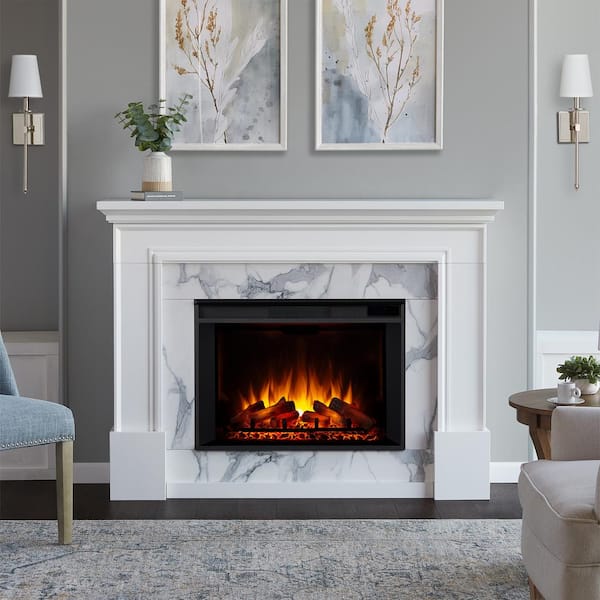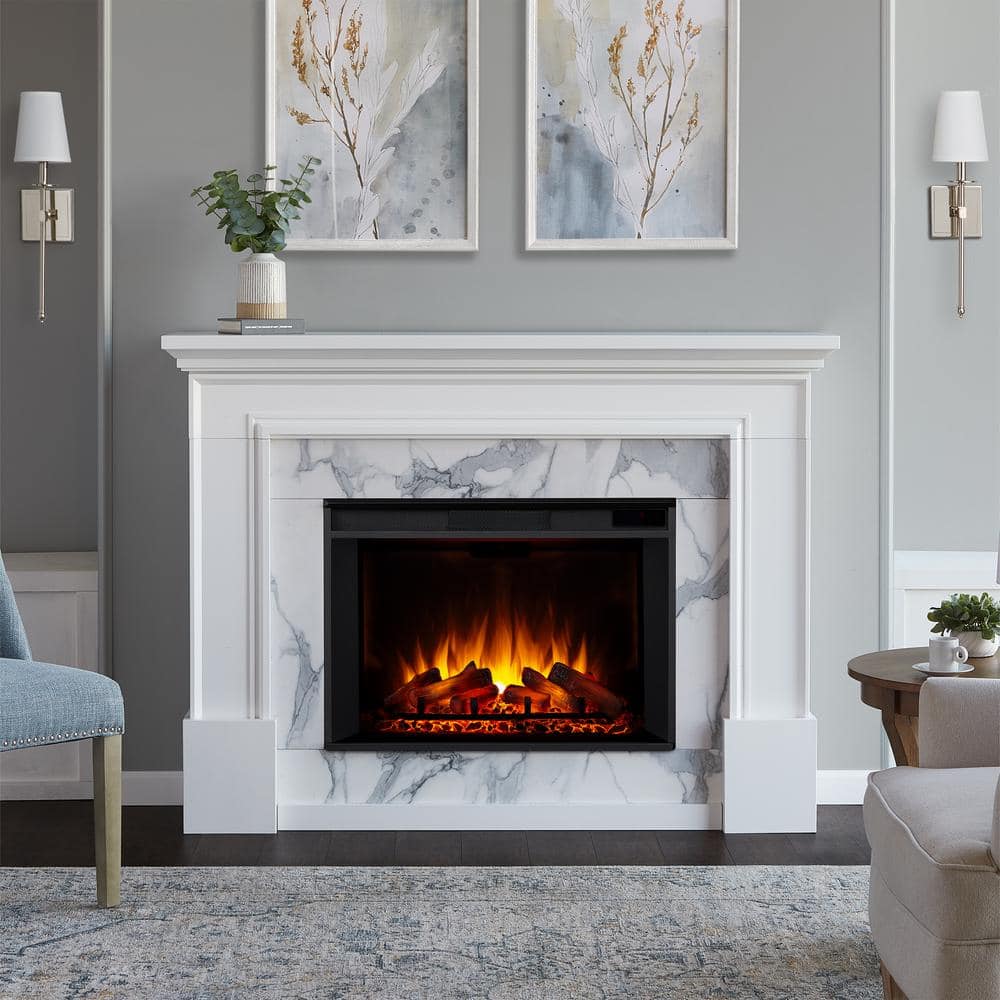An electric fireplace works by producing heat through electricity using a heating coil or infrared technology. The heating element warms up, and a fan circulates the heated air into the room.
Electric fireplaces offer the convenience of easily plugging into a wall outlet and functioning with or without heat, providing both warmth and ambiance. They do not have real flames but use the heating element to emit radiant heat promptly. Whether as a freestanding unit or part of a traditional fireplace setup, electric fireplaces are a modern, energy-efficient option for heating spaces efficiently.
If you’re considering an electric fireplace, understanding how they work and their benefits can help you make an informed decision for your home.


Credit: www.homedepot.com
Understanding Electric Fireplaces
Electric fireplaces work by using electricity to power a heating element and LED lights, which create the visual effect of a flame. They can also operate with or without the heat, providing a cozy ambiance with just the flame setting.
These fireplaces are a convenient and energy-efficient alternative to traditional wood-burning fireplaces.
How Do Electric Fireplaces Work?
Electric fireplaces work by utilizing electricity…
to power heating elements and LED lights…
that mimic the appearance of a traditional flame.
Realistic Flames In Electric Fireplaces
Realistic flames in electric fireplaces…
are achieved through the use of advanced technology…
such as LED lights and reflective panels.
Components Of An Electric Fireplace
The components of an electric fireplace include a heater, fan, LED lights, and a flame effect mechanism. The heater provides warmth while the fan distributes heat evenly. LED lights create a realistic flame effect, giving the ambiance of a traditional fireplace in a hassle-free way.
The workings of an electric fireplace are driven by several key components that collectively create a cozy and efficient heating experience. Understanding these components can help you appreciate the technology behind this modern heating solution.Heating Element
One of the fundamental components of an electric fireplace is the heating element. This element produces the heat that warms your space, mimicking the comforting warmth of a traditional fireplace.Fan Design
The fan design in an electric fireplace plays a crucial role in distributing the heat generated by the heating element efficiently. This feature ensures that the warmth is spread evenly throughout the room, providing a consistent and cozy atmosphere.Flame Forward Technology
Flame Forward Technology is a innovative feature that enhances the visual appeal of electric fireplaces. This technology creates realistic flame effects that simulate the appearance of a traditional fireplace, adding ambiance to your living space. By combining these elements, electric fireplaces offer a convenient and eco-friendly alternative to traditional fireplaces, providing both warmth and visual charm without the hassle of maintenance.Advantages And Disadvantages
Electric fireplaces have become increasingly popular due to their convenience and ease of use. However, like any appliance, they come with their own set of advantages and disadvantages. Understanding these can help you make an informed decision about whether an electric fireplace is the right choice for your home. Below, we will explore the advantages and disadvantages of electric fireplaces.
Advantages Of Electric Fireplaces
- Easy Installation: Electric fireplaces are easy to install, as they simply require a power outlet. There is no need for venting or chimney access, making them a versatile option for various rooms in a home.
- Low Maintenance: Unlike traditional wood-burning fireplaces, electric fireplaces do not produce ashes or soot, resulting in minimal maintenance and cleanup.
- Energy-Efficient: Electric fireplaces are highly energy-efficient, as they only heat the room they are in, thereby reducing overall energy consumption compared to central heating systems.
- Adjustable Settings: Most electric fireplaces come with adjustable settings for heat, flame effects, and brightness, allowing for customization based on individual preferences.
Disadvantages Of Electric Fireplaces
- Limited Heating Capacity: Electric fireplaces are not intended to serve as the primary heat source for a home and typically provide as much heat as a small electric space heater.
- Dependence on Electricity: Since electric fireplaces rely on electricity to function, they are rendered inoperable during power outages, unlike traditional fireplaces that can still provide heat and light.

Credit: magikflame.com
Electric Fireplace Energy Consumption
An electric fireplace is not only a stylish and convenient addition to your home, but it also offers an efficient way to heat your space. Understanding its energy consumption can help you make informed decisions about its usage and cost-effectiveness. In this section, we will explore various aspects of electric fireplace energy consumption, including electricity usage and operating during power outages.
Electricity Usage
When it comes to electricity usage, electric fireplaces are known for their energy efficiency. These fireplaces typically have adjustable heating elements, allowing you to control the amount of heat generated. The power consumption of an electric fireplace depends on the heat setting you choose. On average, a typical electric fireplace consumes around 1.5 to 2.5 kilowatts per hour. This means that if you run your electric fireplace for an hour, it will consume approximately 1.5 to 2.5 kilowatt-hours of electricity.
It’s important to note that electric fireplaces also have a flame effect feature, which enhances the ambiance of your space. Unlike the heating element, the flame effect uses minimal energy and can be operated independently of the heat function. This allows you to enjoy the cozy and realistic flame effect without consuming a significant amount of electricity.
Operating During Power Outages
One of the advantages of electric fireplaces is their ability to operate even during power outages. Most electric fireplaces are designed with a battery backup system that allows them to function even when the power is off. This ensures that you can still enjoy the warmth and ambiance provided by your electric fireplace during unexpected power interruptions.
The battery backup system of an electric fireplace typically consists of rechargeable batteries that automatically activate when the power goes out. These batteries are designed to provide enough energy to keep the fireplace running for a limited period, usually a few hours. This feature not only ensures your comfort but also offers a sense of security during power outages.
It’s worth noting that the battery backup system may vary depending on the model and manufacturer of your electric fireplace. It’s recommended to consult the user manual or contact the manufacturer to understand the specific operating capabilities of your fireplace during power outages.
In conclusion, electric fireplaces offer a cost-effective and energy-efficient heating solution for your home. With their adjustable heating elements and minimal energy consumption for the flame effect, you can enjoy the warmth and atmosphere without worrying about high electricity bills. Furthermore, the battery backup system allows you to rely on your electric fireplace even when the power goes out. Considering these factors, electric fireplaces are a practical and convenient choice for heating your space.
Choosing The Right Electric Fireplace
When it comes to choosing the right electric fireplace for your home, there are a few key factors to consider. The flame setting and heating functionality are two important considerations that will help you make the best decision. Let’s explore these factors in more detail below.
Considerations For Flame Setting
The flame setting is a crucial element of any electric fireplace, as it adds a cozy and realistic ambiance to your space. When selecting an electric fireplace, you’ll want to consider the following:
- Flame Realism: Look for an electric fireplace that offers a realistic flame effect. Some models even have adjustable flame brightness and color settings, allowing you to customize the ambiance to your preference.
- Flame Technology: Pay attention to the flame technology used in the electric fireplace. Advanced flame forward technology can create a more lifelike and natural flame effect.
- Flame Control: Check if the electric fireplace offers different flame intensity levels or a thermostatic control, so you have full control over the flame’s appearance.
Heating Functionality
In addition to the flame setting, the heating functionality of an electric fireplace is another essential aspect to consider. Here are a few things to keep in mind:
- Heating Capacity: Determine the heating capacity of the electric fireplace. Consider the size of your room and ensure that the electric fireplace can provide enough warmth to keep you comfortable.
- Heat Distribution: Look for an electric fireplace that evenly distributes heat throughout the room. Some models come with a built-in fan to help circulate warm air effectively.
- Heat Settings: Check if the electric fireplace offers multiple heat settings, so you can adjust the temperature according to your needs. This flexibility allows you to enjoy the fireplace’s ambiance without overheating the room.
Remember, it’s crucial to choose an electric fireplace that aligns with your specific needs and preferences. By considering both the flame setting and heating functionality, you can find the perfect electric fireplace to enhance the ambiance and warmth of your living space.
:max_bytes(150000):strip_icc()/spr-duraflame-3d-infrared-electric-fireplace-stove-at-amazon-rmarek-02-0200-2e0b58bafa4d47f4879c8df978a5a2f5.jpg)
Credit: www.thespruce.com
Frequently Asked Questions On How Does An Electric Fireplace Work
What Are The Disadvantages Of An Electric Fireplace?
Disadvantages of an electric fireplace include limited heating capacity like a small space heater and reliance on electricity, unavailable during power outages.
Do Electric Fireplaces Use A Lot Of Electricity?
Electric fireplaces generally use up to 1500 watts, so they do consume electricity, but not excessively.
Do Electric Fireplaces Just Plug In?
Electric fireplaces just plug into a wall outlet and can be used with or without heat. They provide the ambiance of a fire without the need for a real flame. They are not designed to be the main heat source and run on electricity.
Does An Electric Fireplace Have A Flame?
An electric fireplace does not have a real flame. It uses a heating element to create radiant heat that warms the room. It can be either freestanding or designed to look like a traditional fireplace.
How Do Electric Fireplaces Work?
Electric fireplaces use electricity to power a heating element and create a realistic flame effect for ambiance.
Conclusion
To sum up, electric fireplaces work by using electricity to power heating elements and a fan to circulate warm air. They also create a realistic flame effect with LED lights and mirrors. Despite not being a primary heat source and reliance on electricity, electric fireplaces offer convenience and ambiance without the need for a chimney or vent.
If you need a reliable and stylish heating option, electric fireplaces are definitely worth considering.